- Quick Read
- Deep Read ( 8 Min. )
Monitor Daily Podcast
- Follow us:
- Apple Podcasts
- Spotify
- RSS Feed
- Download
TODAY’S INTRO
After 60 years of persistence, Wally Funk becomes an astronaut
If you’re going to strap yourself into a 60-foot-tall rocket in West Texas, you’d probably want the experience, verve, and exuberance that Mary Wallace “Wally” Funk brings.
On Tuesday morning, Ms. Funk joined Amazon’s Jeff Bezos; his brother, Mark; and Dutch teenager Oliver Daemen on their Blue Origin journey to the edge of space. In doing so, the 82-year-old pilot became the oldest person ever to fly above the Kármán line, the boundary of space. But that’s not really too surprising. Ms. Funk has had a lifetime of firsts:
But what probably put her on Mr. Bezos’ radar was her participation in the Mercury 13. In 1961, as NASA prepared seven American male astronauts for the new frontier of space, a secret, privately funded group of female pilots underwent – and passed – the same NASA tests.
None of the 13 women were given the opportunity to touch the hem of space – until today. “They’d say, ‘Wally, you’re a girl, you can’t do that!’ Guess what? You can still do it if you want to do it. And I like to do things that nobody has ever done,” said Ms. Funk recently.
And so she has, once again. “I loved it!” she exclaimed afterward.
Share this article
Link copied.

Help fund Monitor journalism for $11/ month
Already a subscriber? Login

Monitor journalism changes lives because we open that too-small box that most people think they live in. We believe news can and should expand a sense of identity and possibility beyond narrow conventional expectations.
Our work isn't possible without your support.
As floodwaters recede in Europe, helping hands come rushing in
As often happens after a flood, there comes a deluge of generosity. We look at that outpouring of community support in Germany and Belgium after catastrophic storms.

-
Dominique Soguel Special correspondent
Flooding not seen for more than a century in some parts of Germany and Belgium caused widespread damage, with nearly 200 deaths confirmed so far. But as people grieve and clean up, the dominant feeling for many is heartfelt gratitude for the community spirit that emerged.
Frank Schneising and his United Biker colleagues began rotating in shifts to help the community in Heimersheim near Stuttgart. First they checked houses for people, then began helping to clear debris and do whatever needed doing. The effort brought together strangers from all over Germany. “People just came streaming into the town. Whenever there was something to do, there were people ready to do whatever without us even asking,” says Mr. Schneising.
In Liège, Belgium, a woman won hearts over the weekend by organizing her neighbors to distribute nearly 1,000 pancakes because she couldn’t help clear the debris. So did members of the North African community who brought treats for those engaged in the cleanup.
“Seeing all the destruction and all the work that people – who have nothing left – need to do, I could not just sit on the couch,” says Ysabelle Adolphe, who helped clean four houses in the span of three days. “In Belgium, everybody is like this; when you need them, they are there.”
As floodwaters recede in Europe, helping hands come rushing in
When Rita Werner was growing up in northwestern Germany, her mother always spoke of the floor tiles in the hallway. “She would say, ‘If they started getting wet and didn’t dry, then the groundwater is starting to rise and the storm is coming,’” says Ms. Werner.
Six years ago, the child social worker returned to her childhood home in Kommern, a town 30 miles from Cologne. Those floor tiles are now her responsibility. Ahead of last week’s news of a large storm brewing, Ms. Werner began toting books and valuables out of the basement and placing them on the top stair. Soon enough, the tiles started getting wet.
“Then the snails started climbing the walls” to escape water, she says.
The flood that devastated regions in Germany and other parts of Europe was beyond anyone’s experience – or imagination. Ms. Werner, in the center of one of the hardest-hit areas in Germany, brought a pump down to the basement to remove water. But within a half-hour, “a huge brown soup flooded the street. That’s when the street turned into a river,” she says, pouring nearly 6 feet of water into her basement and demolishing the town bridge.
Flooding killed nearly 200 people in Germany and Belgium – with rescuers still looking for more casualties – and also devastated parts of the Netherlands, Switzerland, and Luxembourg. As people grieve and clean up, some wonder whether Europe is adequately equipped to cope in the face of extreme climate events. But the dominant feeling for many is heartfelt gratitude for the community spirit that emerged to usher survivors through a once-in-a-lifetime flood devastation.
“We are totally overwhelmed by the willingness to help that we have seen in the past couple of days,” says Patrick Pöhler, spokesperson for the Malteser, an international Roman Catholic relief organization that has fielded millions of euros in donations in the past few days. “We have been getting nonstop offers to donate and help in any way possible. People want to donate things, or manpower, or even money. We are so proud of our community for that.”
“I just get goose bumps when I think of how everyone is helping us – the togetherness is just amazing,” says Ms. Werner. “My neighbors both took the day off of work tomorrow ... and will come help me clean out the mud from my basement. Through Twitter ... just now [a stranger] from Offenbach sent me a message. He’s bringing me dehumidifiers tomorrow and machines to soak up the mud.”
“It’s the trust and togetherness”
Frank Schneising says residents of Ahr Valley sometimes view motorcycles negatively because of a few loud motorcyclists. This week, he and his United Biker colleagues were a welcome addition to the rescue effort because they went straight to where help was needed. “If you want to ride in this area in the future, then you need to come now and help out,” he messaged his fellow motorcyclists.
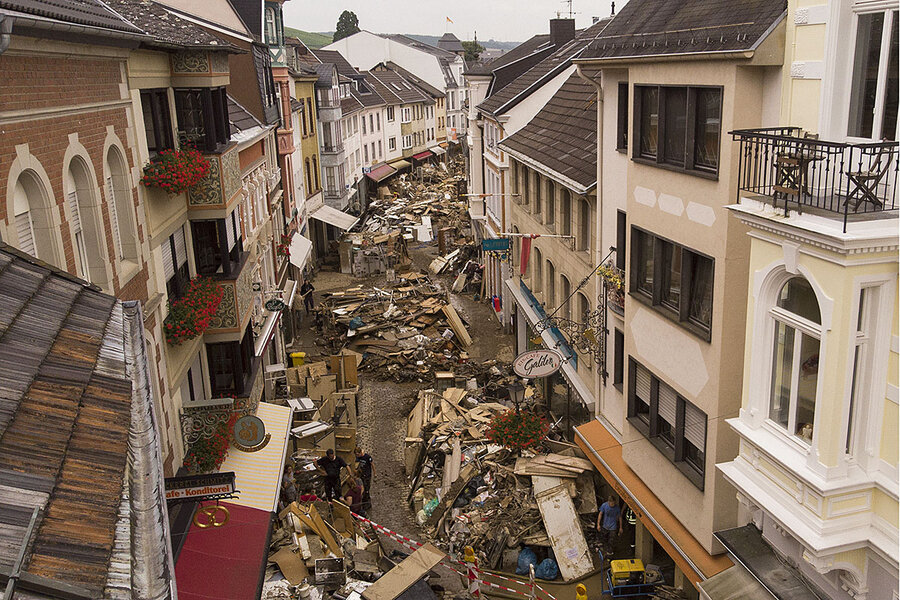
And they came. Mr. Schneising mobilized groups of 30 bikers each, who began rotating in shifts to help the community in Heimersheim near Stuttgart. The group drove in as far as it could, gathered wheelbarrows and shovels, and then began walking. “The streets don’t exist anymore; there’s no way to get through with a car,” says Mr. Schneising of hard-hit flood areas. “On the first day, the debris was piled so high – wood, old pieces of furniture, all over the place. Cars were piled on top of each other.”
First they checked houses for people, then began helping to clear debris and do whatever needed doing. The effort brought together strangers from all over Germany, working silently in tandem.
“People just came streaming into the town. Whenever there was something to do, there were people ready to do whatever without us even asking,” says Mr. Schneising. “No one said a word. We were standing in mud up to our chests at one point, and people were emotionally exhausted, but the unbelievable things we were seeing had such an effect on people.”
The pandemic gave Mary Sherrer, a Bavarian Red Cross volunteer, a head start on organizing volunteers via Facebook. “In the first lockdown there were no masks [available] so I started a Facebook group because I couldn’t sew,” says Ms. Sherrer, who works as a business administrator. “Within a few hours, 4,500 people from Würzburg joined. That’s stayed intact until today. It’s the trust and togetherness that makes this group so special.”
The group has offered people an online platform to seek help, and it’s also mobilized groups to travel to hard-hit areas in the western state of North Rhine-Westphalia.
Meanwhile, in Euskirchen, where the flood devastation is most intense, donations are pouring in. Corinna Lawlor, a Euskirchen employee working as a temporary spokesperson during the flood, says that “anything you can possibly imagine, it’s been donated. We have had semitrucks drive up here, filled with things to donate. But we don’t know where to store it anymore.”
“When you need them, they are there”
Similar scenes played out in Belgium, which was holding a national day of mourning on Tuesday for the 31 people killed in extreme weather. The initial outpouring of solidarity proved so intense that the Belgian Red Cross had to ask people to stop bringing in spare clothes and household goods so that volunteers wouldn’t be bogged down by sorting and could go help where needed.
In Liège, Belgium’s third-largest city, a woman won hearts over the weekend by organizing her neighbors to distribute nearly 1,000 pancakes because she couldn’t physically help to clear the debris. So did members of the North African community who brought out sweet treats for those engaged in the cleanup. The governor set up a special cell to help structure voluntary efforts and donations.
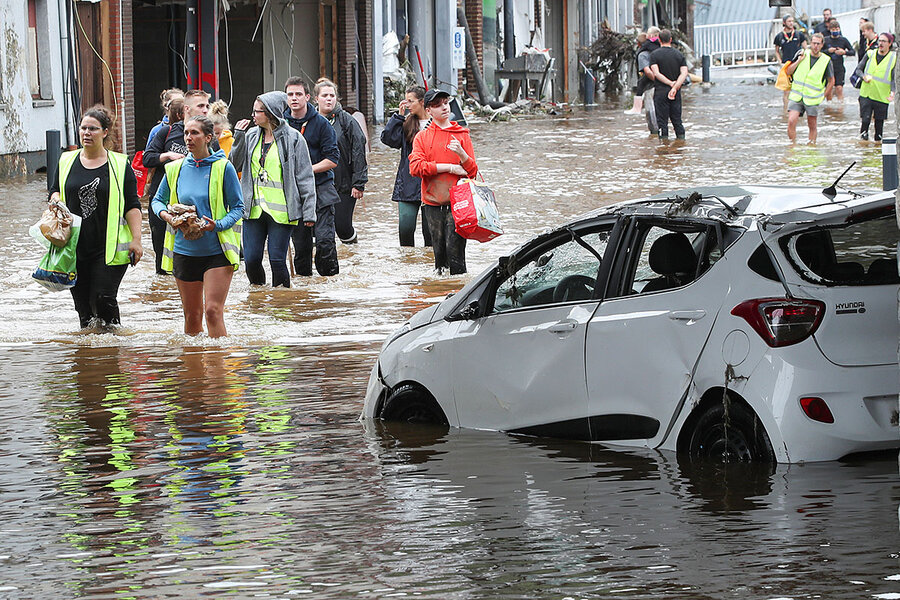
“Seeing all the destruction and all the work that people – who have nothing left – need to do, I could not just sit on the couch,” says Ysabelle Adolphe, whose house on higher ground was spared the devastation of neighborhoods by the river. She helped clean four houses in the span of three days, striking up new friendships with fellow helpers along the way. “In Belgium, everybody is like this; when you need them, they are there.”
Antoine Iseux, spokesman of the Belgian Crisis Center, hailed the “exceptional” mobilization of Belgians but was also grateful for the European Union, which activated its aid mechanism. France, Italy, and Austria made their presence felt by sending specialized teams and equipment to help rescue operations as streets flooded, cars floated, and people scrambled to higher ground.
“We hadn’t seen such flooding in Belgium in more than a hundred years,” he said. “The population was shocked by this rise in water and the damage that it could do. But what I take away is the gestures of solidarity. Our work [now] is to clear the debris, unblock the roads, and ensure the stability of buildings.”
It could take weeks, he noted, for the situation to return to normal.
Lessons to be learned?
With better weather this week came relief, but also shock at the extent of the devastation. The high death toll in Germany, a wealthy nation unaccustomed to natural disasters, raised tough questions about the European Union’s capacity to predict and confront increasingly extreme climate events – and adequately communicate the risks to its population. The timing of the disaster also struck a powerful chord; the problems began shortly after the bloc revamped its climate strategy.
Several German politicians were quick to blame “climate change” – a welcome but overdue recognition of the problem for activists. European Commission President Ursula von der Leyen said the intensity and length of the flood events offered a “clear indication of climate change and that this is something that really, really shows the urgency to act.” Critics considered their declarations an effort to dodge responsibility and adequately reflect on the lessons of Germany’s “Hurricane Katrina” moment.
The European Flood Awareness System issued an early warning of extreme flooding risk at the beginning of last week. But at the national level, SMS evacuation warnings and coordination efforts in some cases came too late. “The death toll could well have been significantly lower had all the affected areas used the intelligence provided by the early warnings to preventively evacuate all the high-risk areas,” says Khaled Diab, a spokesman for the umbrella organization European Environmental Bureau.

“One reason that this didn’t happen was that flooding on such a massive scale is largely uncharted territory for this part of the world,” he explains. “Another major factor was the labyrinthine nature of the disparate national and regional authorities involved. One hopes that lessons will be drawn from this, the most important being that the environment does not recognize nor respect political boundaries and borders.”
Dieter Gerten, professor of global change climatology and hydrology at Germany’s Potsdam Institute for Climate Impact Research, shared that view. Western Germany, along with the affected areas of Belgium and the Netherlands, he notes, were exposed to unprecedented levels of rainfall, often in vast areas with no history of flooding.
“While such extreme events (as well as heat waves and droughts) can be generally expected in the course of ongoing global warming, the magnitude of this one appears to have surprised many,” he says. “Solidarity among people in the region and the country was very high. Yet now we need to prepare institutions and civil society even better for possible further – and potentially larger – climatic extreme events in the future.”
Taking what one can
Back in Liège, Ilham Ait Omar wonders if her home, next to the Vesdre River, will ever be inhabitable again. The water, she says, started gushing into her home at 3:40 p.m. on Wednesday. She immediately rushed out with her son and daughter and helped evacuate a couple of neighbors. Those they couldn’t help had to wait for firefighters to come a full day later, which is when an SMS message arrived urging evacuation.
“What can the authorities do in the face of such situations?” asks Ms. Ait Omar. “I don’t want to blame them. Everyone did what they could. We couldn’t cope with our own policemen or firemen. It was beyond a crisis.”
As a mother, she worries about the toll that the experience will take on her children, so she returns home first thing in the morning and leaves late at night hoping to finish the cleanup. Although the nights are tough because the reality of all that has been lost sinks in, the overwhelming support she has received from her community – including Ms. Adolphe, who is her daughter’s rugby coach – and complete strangers helps carry her forward and brings joy to her days.
“I’ve had a tremendous amount of help. People have come from other parts of Belgium, even France,” she says. “We see people who are in even greater need than us so we don’t dwell on our problems, even if they are important.”

Russia worries: Will US exit from Afghanistan bring back bad old days?
As U.S. troops exit Afghanistan, it reminds Russians of the regional turmoil after their own exodus three decades ago. Our reporter looks at why the past may not be a prologue.

- Quick Read
- Deep Read ( 6 Min. )
The United States’ current pullout from Afghanistan is a déjà vu moment for a lot of Russians. However, this time it’s not their own troops pulling out in defeat, as happened in 1989 when the Soviets withdrew. Rather, it is those of the adversarial alliance NATO, which after almost 20 years, can’t claim any better military success than the USSR achieved.
Not surprisingly, there’s a bit of schadenfreude on display in Russian media commentary. But overshadowing that are feelings of uncertainty, even dread. The Soviet withdrawal from Afghanistan is a painful memory that weighs heavily upon all current decision-making.
It began with the collapse of the USSR itself – at least partly due to the Afghan war. It also led to a five-year civil war in Russian-allied Tajikistan. A badly weakened Russia also faced Islamist rebellions in its mainly Muslim North Caucasus region.
“Russia’s experience in Afghanistan in the ’80s and its aftermath were traumatic,” says Vladimir Sotnikov of Moscow’s Institute of Oriental Studies. “That trauma still remains, ingrained in the emotions of Russian officials and average people alike. Now, as we watch what looks like a hasty and chaotic American departure from Afghanistan, it raises a lot of fears and apprehensions.”
Russia worries: Will US exit from Afghanistan bring back bad old days?
An iconic set of images from 32 years ago has been appearing anew in the Russian media of late. The images depict the commander of the Soviet Union’s “limited contingent” of forces in Afghanistan, Gen. Boris Gromov, striding across the ironically named Friendship Bridge between Uzbekistan and Afghanistan in early 1989, as the last of his forces rumbled out of the country after nine years of futile attempts to impose pro-Soviet order.
The United States’ swift pullout from Afghanistan that’s happening now is a déjà vu moment for a lot of Russians. However, this time it’s not their own troops pulling out in defeat, but those of the adversarial alliance NATO, which after almost 20 years, can’t claim any better military success than the Soviets achieved.
Not surprisingly, there’s a bit of schadenfreude on display in Russian media commentary. But overshadowing that are feelings of uncertainty, even dread. The Soviet withdrawal from Afghanistan is a painful memory that weighs heavily upon all current decision-making, mainly because the chaos that followed ushered in at least a decade of catastrophe, beginning with the collapse of the USSR itself – at least partly brought on by the stresses of the Afghan war.
It also led to a five-year civil war in Russian-allied Tajikistan, with anti-government fighters taking refuge in tumultuous next-door Afghanistan, and incursions by Afghan-based Islamist militants into next-door Uzbekistan. A badly weakened Russia itself faced Islamist rebellions in its mainly Muslim North Caucasus region, which spread deadly terrorist acts into Russia’s heartland for many years.
“Russia’s experience in Afghanistan in the ’80s and its aftermath were traumatic,” says Vladimir Sotnikov, an expert with the official Institute of Oriental Studies in Moscow. “That trauma still remains, ingrained in the emotions of Russian officials and average people alike.
“Now, as we watch what looks like a hasty and chaotic American departure from Afghanistan, it raises a lot of fears and apprehensions,” he adds. “It also strictly limits what Russia will be able to do as the situation unfolds. Because of the past experience, there is no possibility whatsoever that Moscow will introduce even the smallest military force into Afghanistan.”
“Russia is worried”
The speed of the U.S. withdrawal and the rapid Taliban advances that have followed have heightened this sense in Moscow that history may be about to repeat itself.
“The uncertainty of the development of the military-political situation in this country and around it has increased,” Russian Foreign Minister Sergey Lavrov said last week. “Unfortunately, in recent days we have witnessed a rapid degradation of the situation in Afghanistan. ... It is obvious that in the current conditions there are real risks of an overflow of instability to neighboring states.”
More than 1,000 Afghan government troops recently sought refuge in Russian-allied Tajikistan, as Taliban forces rapidly occupy border crossings to that republic and the other two adjacent post-Soviet states, Uzbekistan and Turkmenistan. All three countries have ordered military mobilization, with Tajikistan calling up 20,000 reservists and moving the Russian 201st army division, which has been based in the republic for decades, to take up border positions. Moscow has pledged full support for its regional allies in the Collective Security Treaty Organization, which include Tajikistan, Kazakhstan, and Kyrgyzstan (but not Uzbekistan and Turkmenistan).
“The threat to Tajikistan is real, not just the danger of attack, but the refugees coming into the country that might include all kinds of people, such as spies, Taliban emissaries, and who knows what else?” says Viktor Baranets, a former military spokesman who’s now a columnist with the daily Komsomolskaya Pravda. “Russia is worried that this infection might spread to other republics, leading to bloodshed, perhaps even civil war, and calls for Russian intervention. ... Russia is facing a lot of its own internal problems, so Putin has told Tajikistan to strengthen its own army, double frontier guards, try to protect itself.”
But many Russian security experts argue that circumstances are very different from 30 years ago. Russia and its central Asian allies are much more stable, and the Taliban have changed a lot under the impact of 20 years of hard fighting against NATO. In early July, a Taliban delegation visited Moscow and reportedly gave Russia assurances that they would not seek to expand their conflict with the central government in Kabul beyond the country’s borders.
“The Taliban representatives were saying all the right words, that they will not have any expansionist goals even if they win in Afghanistan, and that they are willing to work with Russia and China to improve regional security,” says Andrey Kortunov, head of the Russian International Affairs Council, which is affiliated with the foreign ministry. “I am not sure that Moscow is buying this, but we have to hope that the Taliban has learned a lot and become more mature and pragmatic. What are our options?”
Even the legendary General Gromov, interviewed by Komsomolskaya Pravda this month, expressed doubts that a potentially victorious Taliban would pose a serious threat to the region.
“The Taliban are not such fools or adventurers to throw themselves on someone else’s machine guns,” he said. “They aren’t actually all that strong, and they have a hard job ahead to gain a foothold on power in Afghanistan. They don’t need to make enemies by attacking other countries.”
Still room for the U.S.?
One open question is whether Russia will acquiesce to the establishment of U.S. military bases in neighboring central Asian countries – after forcing them to close two bases in Kyrgyzstan and Uzbekistan a decade ago – so that American forces might maintain direct support for the Afghan government during the troubled times ahead.
It’s often forgotten that Russia strongly supported NATO’s occupation of Afghanistan 20 years ago, allowed the U.S. to use Russian airspace for its resupply chain, and frequently urged NATO not to leave Afghanistan until the job of stabilizing the country was finished. It was only amid the more general souring of relations between Moscow and Washington in recent years that Russia grew irritated with the ongoing U.S. presence, and controversial rumors of Kremlin opposition grew.
There seems little likelihood that Moscow will agree to new U.S. bases in a region where, together with China, it has been at some pains to cleanse out foreign military influences. But Russian news reports suggest that, during last month’s Geneva summit, President Vladimir Putin may have offered President Joe Biden the use of existing Russian bases in Tajikistan and Kyrgyzstan, at least to operate drones for monitoring the situation in Afghanistan.
“It is the feeling in Moscow that the U.S. is not able to, or even interested in, maintaining a presence in the region to guarantee any particular future direction in Afghanistan,” says Fyodor Lukyanov, editor of Russia in Global Affairs, a leading Moscow-based foreign policy journal. “The Americans are leaving, and it seems to us that they pretty much intend to forget about Afghanistan. The U.S. is signaling to everyone else in the region that it’s up to them from now on.”
Another critical issue for Moscow is the explosion of drug production that took place during NATO’s stewardship in Afghanistan.
“We hope that the Taliban, which never really favored the production and export of opium, will take some steps against it” if they come into a position of power, says Mr. Kortunov.
“Indeed, if there are some efforts at drug reduction, and Afghanistan ceases to be a base for terrorist operations against its neighbors, I think that Moscow could live quite comfortably with a future Taliban government in Kabul – although, like everyone else, we would prefer something more inclusive,” he says.

The Explainer
Police reform: Why it’s so tough to get – and keep – the right chief
A new police chief can be a key element of improving community safety. But our reporter found many cities are swapping leaders too often, and that can undermine progress.

- Quick Read
- Deep Read ( 5 Min. )
Police chiefs can be a powerful lever for reform. Cities looking for change in their police departments often turn to new chiefs. But during the past 18 months or so, top cops around the country have been turning over with unusual frequency.
That’s partly because of efforts to reimagine policing in the wake of the murder of George Floyd last year. And churn can be positive. For “old school” chiefs who are “uncomfortable” with increased oversight and questioning about policing, “they’re making a wise decision by leaving the profession,” says Alex del Carmen, a criminologist in Texas.
But there’s also “an incredible amount of institutional memory leaving the ranks of law enforcement,” he adds. “That concerns me.” And some of the chiefs being lost in the churn are younger and reform-minded, putting reforms at risk.
The challenge is finding the right balance. “It takes about five years to create a cultural shift,” says Delrish Moss, who became police chief of Ferguson, Missouri, after the killing of Michael Brown. Changing a chief in the middle of that, when they’ll “want to put their stamp on things,” he adds, “can be confusing.”
Police reform: Why it’s so tough to get – and keep – the right chief

In his 32-year career in the Miami Police Department, Capt. Delrish Moss served under 11 different police chiefs. He learned something from each one, but when he left to become chief of police in Ferguson, Missouri, in 2016, one piece of advice stood out.
Being a police chief means working on a three-legged table. Politicians are one leg, the community another, and the rank-and-file another.
“You have to make sure all the legs are sturdy and balanced,” says Captain Moss, who now works in the police department at Florida International University in Miami.
In Ferguson, he took charge of perhaps the most precarious three-legged table in the country. He was the city’s first permanent chief since the police shooting of Michael Brown triggered a federal investigation and consent decree, as well as nationwide protests against police brutality and systemic racism. The community didn’t trust local police, and it didn’t trust out-of-town police brought in to fix things either – a protest greeted Captain Moss on his first day.
He left Ferguson 2 1/2 years ago to care for his ill mother. He’d accomplished some of his goals by then, he says, such as increasing the number of Black and female officers in the department. But many needed more time.
“It takes about five years to create a cultural shift,” he says. Changing a chief in the middle of that, when they’ll “want to put their stamp on things,” he adds, “can be confusing.”
Changing a police chief can be a powerful lever for reform. But changing them too often can be a hindrance. Historically, chiefs averaged five to seven years at a department, according to Laura Cooper, executive director of the Major Cities Chiefs Association. Today, the average tenure is around two to three years. And in the past 18 months or so, top cops around the country have been turning over with unusual frequency.
That intensified churn is a product of efforts to reimagine policing in the wake of the murder of George Floyd last year. Amid intense scrutiny from the public – and spikes in violent crime – 40 major cities have changed police chiefs since January 2020, says Ms. Cooper. The question: How much churn is too much?
“To institute culture change and really see reforms come to fruition, it takes a little bit of time,” she says. “With turnover every two or three years, you’re not going to see it.”
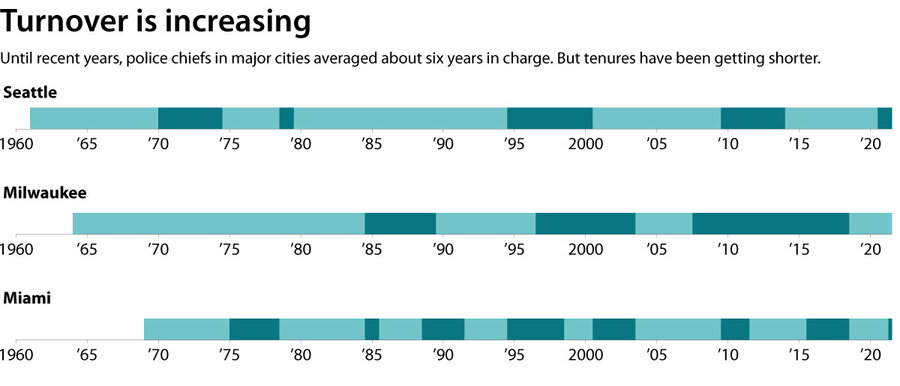
Seattle Times; Seattle Police Department, City of Milwaukee, Miami Police Veterans Association (via Local10.com), Miami Herald
Cities often turn to new police chiefs much like struggling sports teams turn to new head coaches or general managers, hoping to reverse their fortunes. Many police chiefs, in turn, have spread their philosophies as they’ve moved from city to city.
Bill Bratton, for example, controversially pioneered the use of aggressive, data-driven policing to reduce crime over a three-decade career running police departments in Boston, Los Angeles, and New York (twice). Charles Ramsey moved from Chicago to Washington to Philadelphia, developing a model that emphasized community policing and improving recruiting and hiring standards.
In the past 18 months, however, police chiefs have increasingly been leaving not only departments, but also the profession entirely. That’s partly due to a generation of chiefs reaching retirement age. But some younger, reform-minded police chiefs are being forced out, too.

Wikipedia, Houston Chronicle, Waterloo Police Department, Northeastern University, reneehall.org; photos: AP
For “old school” chiefs who are “uncomfortable” with increased oversight and questioning about policing, “they’re making a wise decision by leaving the profession,” says Alex del Carmen, a criminologist at Tarleton State University in Fort Worth, Texas.
But there’s also “an incredible amount of institutional memory leaving the ranks of law enforcement,” he adds. “That concerns me.”
Ms. Cooper says that policing is experiencing a drain of “thought leaders.” For example, former Seattle Police Chief Carmen Best resigned last August after the city council voted to downsize the department. She said the move would disproportionately harm officers of color she’d recently hired.
“That’s an instance where you have a good chief, a forward-thinking chief, who’s dedicated to reform and wants to do the right thing,” says Ms. Cooper, “and she was pushed out.”
Periods of high turnover have happened before.
In 2001, Mary Dodge – a professor of criminology at the University of Colorado – co-wrote a paper examining what she described as “alarmingly high rates of police chief turnover.” Chiefs’ balancing acts are never easy. “They’re trying to please the public, the rank-and-file, and the politicians. You can’t possibly make every constituent happy,” says Professor Dodge.

Fred Rainguet and Mary Dodge, “The Problems of Police Chiefs: An Examination of the Issues in Tenure and Turnover.” Police Quarterly, Vol. 4 No. 3. September 2001
Cities, departments, and chiefs need to better ensure that a change in top cop isn’t “a traumatic event to an organizational culture,” says Professor del Carmen. When a reform-minded chief leaves, the reform process doesn’t have to leave with them.
In Ferguson, Captain Moss lobbied publicly for one of his assistant chiefs, Frank McCall, to succeed him.
“Frank and I had fashioned that vision [for the department] together,” he says. “Had [he] stepped in I think it would have been a smooth transition. … That would have kept fluidity, consistency and momentum.”
Ferguson officials chose someone else, but earlier this year that chief announced that he was leaving to take over a police department in North Carolina. Assistant Chief McCall, who had stayed on after Captain Moss left, became Ferguson’s police chief last week.
Ferguson is now on its sixth police chief in six years. That may be too much turnover for one city, but Captain Moss doesn’t think having churn at the highest ranks of policing in the country is a definitively good or bad thing.
“Every department, every city has to assess what direction they want to go in,” he says. “It really depends on the dynamics on the ground, and who you bring in.”
One thing cities should do, he adds, is heed the lesson of another chief of his in Miami: Everybody knows that police officers don’t study history.
“We need to be better at learning from [the past] and better at examining those things,” he says, “in our profession but [also] on a larger scale.”
That three-legged table, he adds, nationwide, “is in a super precarious position right now.”
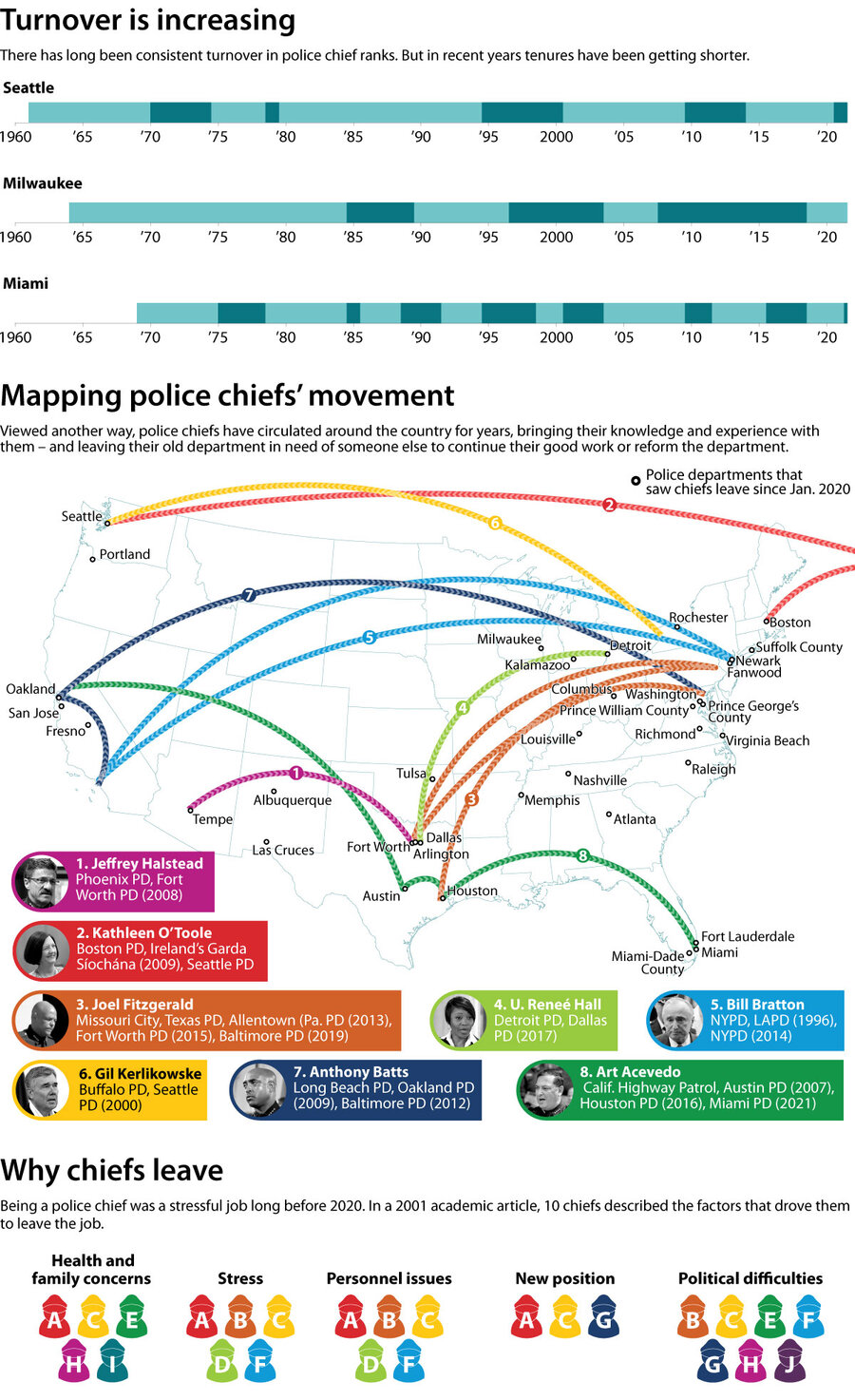
Seattle Times; Seattle Police Department; City of Milwaukee; Miami Police Veterans Association (via Local10.com); Miami Herald; Wikipedia; Houston Chronicle; Waterloo Police Department; Northeastern University; reneehall.org; Fred Rainguet and Mary Dodge, “The Problems of Police Chiefs: An Examination of the Issues in Tenure and Turnover.” Police Quarterly, Vol. 4 No. 3. September 2001; Photos: AP

Amid biking boom, more adults decide it’s finally time to learn
Our reporter shares a story about community, and a trend of overcoming the fear and embarrassment of an activity often conquered by children.
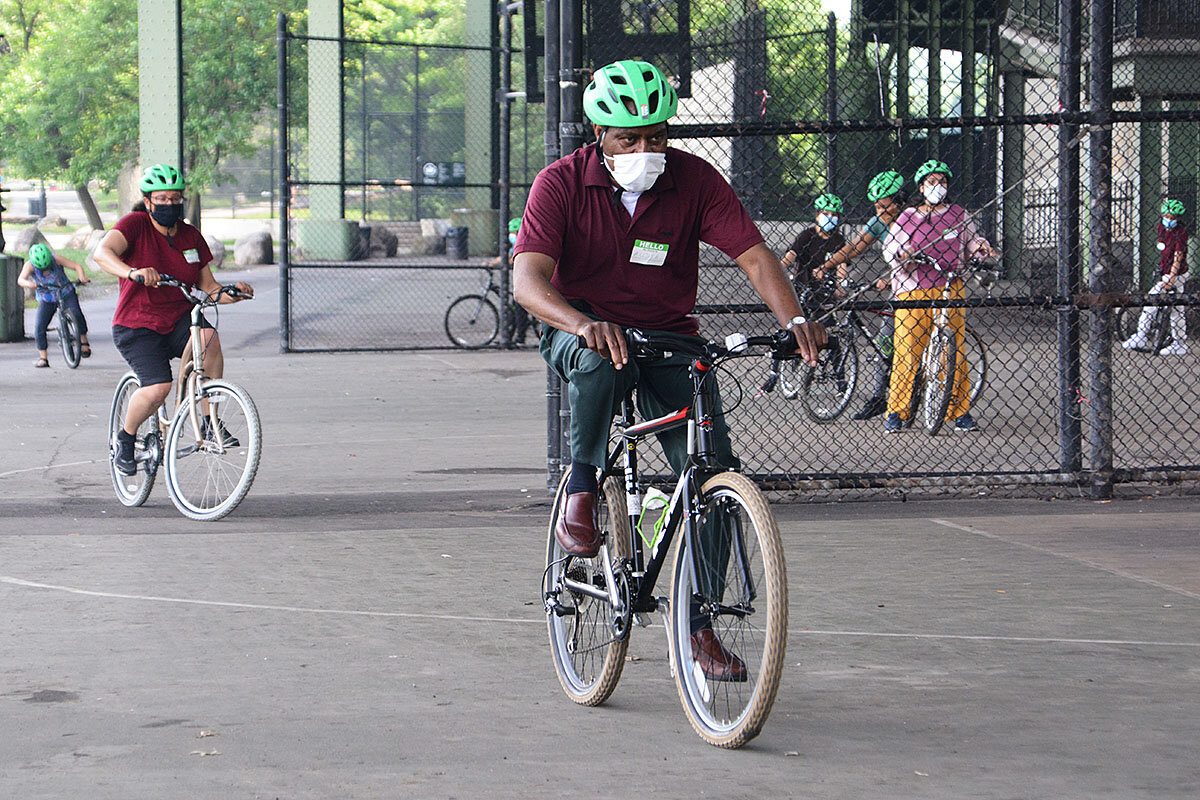
- Quick Read
- Deep Read ( 4 Min. )
During the pandemic, bicycle sales doubled nationwide, as more Americans sought outdoor activities and new means of travel amid concerns about using public transportation.
For some adults, it was a chance to learn a brand-new skill.
Bike New York’s free, two-hour Bike Skills 101: Learn to Ride class started more than a decade ago, after adults started asking if they could enroll in classes for children. Now, with weekly classes across the city, Learn to Ride for adults is the organization’s largest program. More than two-thirds of the students are women, and many are immigrants.
“Growing up in Cameroon, every kid doesn’t have a bike,” says Pamela Kouakam, as she pulls a bright blue bike helmet over her long braids. “And if you never do biking as a kid, you’re terrified to try.”
Ms. Kouakam, who lost her job as an accountant during the pandemic, decided to push past her fear.
“My 8-year-old daughter always says, ‘Mommy let’s go ride our bikes together,’ and I just felt so left out,” she says. “I want to do this with my daughter.”
Amid biking boom, more adults decide it’s finally time to learn
Sitting on a bench in Riverside Park, off 158th street in Harlem, the group of women anxiously check their phones and watches, waiting for 10 a.m.
They exchange knowing smiles and nods, because these women share a secret: They don’t know how to ride a bicycle.
“Growing up in Cameroon, every kid doesn’t have a bike,” says Pamela Kouakam, as she pulls a bright blue bike helmet over her long braids. “And if you never do biking as a kid, you’re terrified to try.”
Despite her fear, Ms. Kouakam, who lost her job as an accountant during the pandemic, decided it was time to learn.
“My 8-year-old daughter always says, ‘Mommy let’s go ride our bikes together,’ and I just felt so left out,” she says. “I want to do this with my daughter.”
Ms. Kouakam is one of a dozen women enrolled in Bike New York’s free, two-hour Bike Skills 101: Learn to Ride class for adults. The program started more than a decade ago, says Bike New York’s Education Director Richard Conroy, after adults started asking if they could enroll in classes for children. Now, with weekly classes across the city, Learn to Ride for adults is the organization’s largest program.
Since 2011, Bike New York says it has run more than 850 adult classes with more than 15,000 students. More than two-thirds of the students are women, Mr. Conroy estimates, and many are immigrants.
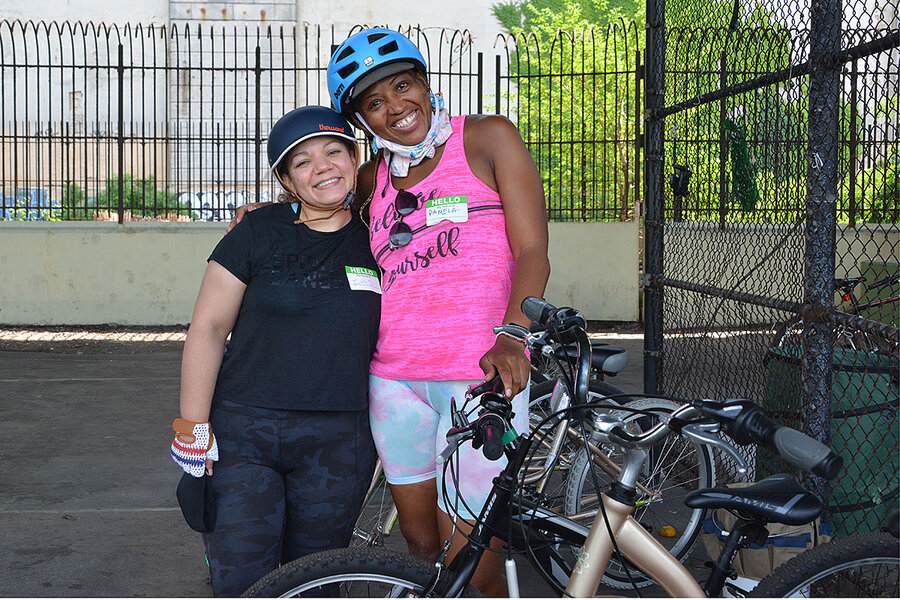
Reasons for wanting to learn differ. Some students say they’d like to commute to work on a bike because it’s cheaper and better for the environment. Some are looking for a new way to exercise. Many, like Ms. Kouakam, say they want to learn so they can ride bikes with family and friends.
Almost everyone in the class says they simply want to learn how to do something they’ve never done before.
“I feel embarrassed when I see people riding a bike and I can’t,” says Audye Voltaire, the class’s only male student who moved to New York from Haiti five years ago. “I’m scared because I know I may fall down, but it’s worth it. I want to have the fun of riding a bike.”
In recent years, biking has become increasingly popular in the Big Apple. A 2019 city government report found almost half a million cycling trips were made each day in the city in 2017, roughly five times the number in 1980. The number of New Yorkers commuting to work by bike increased 55% between 2012 and 2017, almost double the rate of other major U.S. cities.
During the pandemic, bike sales doubled nationwide, as more Americans sought outdoor activities and new means of travel amid concerns about using public transportation. Last month, the bike sharing company Citi Bike announced a new record on Twitter: 123,185 rides in one day.
Shortly after Mr. Conroy arrives by bike, the students grab bikes and helmets from Bike New York’s storage container and stand in a circle. Some hold their bikes hesitantly; one woman puts her helmet on backward.
“How many of you are scared of falling?” Mr. Conroy asks the class.
A few hands rise.
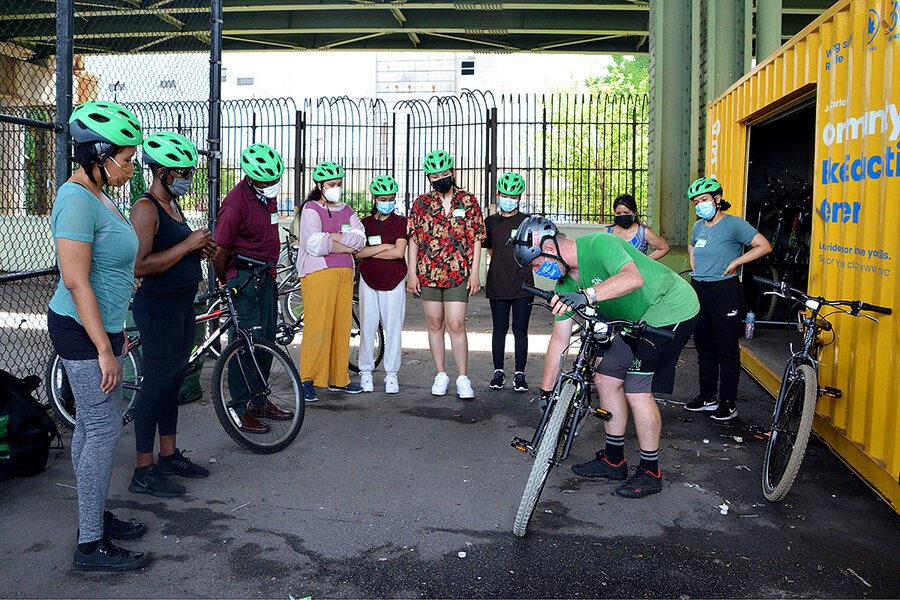
“And how many of you are embarrassed about being an adult who doesn’t know how to ride a bike?” he asks.
All hands shoot up.
Mr. Conroy begins by explaining the correct way to put on a helmet and pointing out the various parts of a bike. He then lowers all of the bike seats and takes off all of the pedals. The students begin their lesson by straddling the bike and pushing forward with both feet, moving counterclockwise around a basketball court.
As the students gain confidence, Mr. Conroy gives them back their pedals, raises their seats, and shows them how to push off and brake. One woman sways back and forth and looks as if she is about to fall before recovering and successfully riding forward several feet. The class erupts in cheers.
By the end of the class, almost everyone is biking full loops around the court on their own.
“At first I was like, ‘No way I will learn how to ride a bike in one day,’” says Iris Polanco, who says her parents didn’t allow her to ride a bike when she moved to the United States from the Dominican Republic as a young child, fearing for her safety. “Now I’m going to sign up for the next class.”
Follow-up classes focus on things like how to work gear shifts and how to ride safely on city streets in traffic.
Students say it’s not just the new skills that they’ll remember.
“The camaraderie of this is amazing,” says Ms. Polanco, an arm around Ms. Kouakam’s waist. The two women met at an earlier bike class and have made plans to meet up. Maybe even for a bike ride.
“As a 38-year-old learning how to ride, I was nervous,” says Ms. Kouakam. “But it’s all people like me here – and now we’re friends.”
Other headline stories we’re watching
(Get live updates throughout the day.)The Monitor's View
Honesty pays off in Moldova
- Quick Read
- Deep Read ( 2 Min. )
-
By the Monitor's Editorial Board
When Maia Sandu is on the campaign trail in her small country of Moldova, her favorite word is “honest.” It helped her last year in being elected president and again on July 11 when her party won a landslide victory in parliamentary elections. The Harvard-trained former World Bank economist is, according to one political analyst, the first person in Moldova to come to power “preserving a reputation for honesty.”
While she says honesty in public officials is key to curbing corruption, Ms. Sandu also emphasizes it as a way out of Moldova’s geopolitical muddle. As in many former Soviet republics, Moldova’s 2.6 million people remain divided in their leanings between Russia and the West – three decades after independence. She understands that the best escape from that tired debate lies in creating an honest and transparent democratic state.
Her party’s website says the current system of governance “does not reward the honest.” But Ms. Sandu promises to “appoint an honest prime minister, honest judges and honest people to all government bodies.” It’s a word she keeps repeating. Perhaps because, in its appeal to people’s desire for truth and trust, it can have real power.
Honesty pays off in Moldova

When politician Maia Sandu is on the campaign trail in her small country of Moldova, her favorite word is “honest.” She uses it to describe “the majority” of her fellow citizens more than herself. “Honest people can be promoted only by citizens,” she says. It helped her last year in being elected president and again on July 11 when her party won a landslide victory in parliamentary elections. The Harvard-trained former World Bank economist is, according to one political analyst, the first person in Moldova to come to power “preserving a reputation for honesty.”
While she says honesty in public officials is key to curbing corruption, Ms. Sandu also emphasizes it as a way out of Moldova’s geopolitical muddle. As in many former Soviet republics, Moldova’s 2.6 million people remain divided in their leanings between Russia and the West – three decades after independence. A fifth of the people speak Russian as a first language and are influenced by Russian TV. She, like similar reformers in Ukraine, Armenia, Georgia, and Belarus, understands that the best escape from that tired debate lies in creating an honest and transparent democratic state with independent courts that simply serve the people.
Her own honesty has now helped put her Action and Solidarity Party into power. Ms. Sandu and the party hope to fix one of Europe’s most corrupt and poorest countries, one sandwiched between Romania and Ukraine. In June, the European Union promised €600 million ($707 million) in aid if reforms are implemented. For now, Russia has lost many of its political allies in Moldova although it has 1,500 troops in the country’s breakaway Transnistria region. President Vladimir Putin could heat up that “frozen conflict” to cause trouble.
Ms. Sandu, the country’s first female head of state, is in a race to clean up government, especially in preventing bribery. As education minister between 2012 and 2015, she achieved some success in preventing cheating in baccalaureate examinations by placing cameras in exam rooms. By one estimate, bribery in education was halved.
Her party’s website says the current system of governance “does not reward the honest.” But Ms. Sandu promises to “appoint an honest prime minister, honest judges and honest people to all government bodies.” It’s a word she keeps repeating. Perhaps because, in its appeal to people’s desire for truth and trust, it can have real power.

A Christian Science Perspective
Each weekday, the Monitor includes one clearly labeled religious article offering spiritual insight on contemporary issues, including the news. The publication – in its various forms – is produced for anyone who cares about the progress of the human endeavor around the world and seeks news reported with compassion, intelligence, and an essentially constructive lens. For many, that caring has religious roots. For many, it does not. The Monitor has always embraced both audiences. The Monitor is owned by a church – The First Church of Christ, Scientist, in Boston – whose founder was concerned with both the state of the world and the quality of available news.
Lessons on integrity in politics
- Quick Read
- Read or Listen ( 4 Min. )
-
By Egil Krogh
To the extent that each of us strives to practice integrity, our communities and world benefit – and everyone is capable of doing this. In this article written some years ago but still relevant today, a man shares life-changing lessons he learned following his pivotal role in the 1972 Watergate scandal.
Lessons on integrity in politics
My integrity was tested in the White House while I was Deputy Counsel to then-President Nixon, and appointed to co-chair the “Plumbers,” a team tasked with discrediting an antiwar activist who released classified documents about US Vietnam War strategy. We were also supposed to track down any other “leaks” of classified documents. But in carrying out our assignment, we broke the law.
Our actions came to light as the Watergate case began to be prosecuted. I chose to plead guilty and willingly accept any sentence the court would impose because I felt I needed to do that in order to reestablish my own sense of integrity.
Some time later, I began to examine what the idea of “integrity” really signifies. The word derives from the root “integer,” which means “whole.” From this, I worked out three questions I could ask to keep my bearings under pressure.
The first is primarily intellectual: “Is the proposed action whole and complete?”
The second addresses the moral dimension, which we often associate with honesty and uprightness. It asks: “Is it right?”
The third question, fundamentally spiritual in nature, is this: “Is it good?” I added this third question because I felt that integrity also means perfection, an unimpaired state. Since God is good, this question really asks, “Is the proposed action Godlike?”
Whenever I’m under enormous pressure or the stakes are high, I’ve found that’s the time to be still and to ask those three questions. And my experience has taught me that when you can answer them affirmatively, you’re safe.
In thinking about responsibility, I was struck by a passage of Mary Baker Eddy’s in “Science and Health with Key to the Scriptures” that says Jesus “did life’s work aright not only in justice to himself, but in mercy to mortals, – to show them how to do theirs, but not to do it for them nor to relieve them of a single responsibility” (p. 18). So while prayer in Christian Science begins with the spiritual premise of “perfect God and perfect man” (Science and Health, p. 259), it’s important to make choices that are in harmony with that premise, which prove it to be true.
That was in a way what led to my guilty plea. I’ve learned in my study and practice of Christian Science that to recognize a sin aids you in destroying it. I had to be clear about the abuse of power that I’d engaged in, so I could honestly say, “That’s not the kind of thought with which I want to be associated any longer.” Then I had to take responsibility for it.
Psalm 26 was extremely helpful, saying, “I have trusted also in the Lord; therefore I shall not slide” (verse 1). And then there’s this conclusion: “I will walk in mine integrity” (verse 11). I got to thinking, What does it mean to “walk in mine integrity”? I was praying with this passage in Science and Health, which uses Mind as a synonym for God: “All that really exists is the divine Mind and its idea, and in this Mind the entire being is found harmonious and eternal” (p. 151). For me, that healing statement defines the source of spiritual integrity. And the next sentence showed me how to walk in this integrity: “The straight and narrow way is to see and acknowledge this fact, yield to this power, and follow the leadings of truth.”
To the extent that we’re clear in consciousness about the power and presence of God, good, Mind, then the path unfolds. And that’s what actually happened in my case. Shortly after I pleaded guilty, one of the most respected Seattle lawyers agreed to represent me in the attorney discipline process. He said we were going to take “the long view.” We needed to find ways for me to show that I’d understood what went wrong and to take steps to correct it. Well, it took us seven years from that moment until I was eventually reinstated by the court to the practice of law. But it all came together because of that farsighted, long-term view.
Now some decades have passed. But breakdowns in integrity and abuses of power are so very much in the news these days. They still need healing.
In many situations, the premium on winning is so high that it overrides a person’s inner sense of what’s right and wrong. You get so swept up with a group and its “groupthink,” that you lose your individual ability to perceive what’s going on. There are also other threats to our integrity that come in the form of vanity, arrogance, or immaturity. But we all have within us, from God, the essential qualities that keep us safe, such as humility.
The challenges and the threats that come along may change. But to stay absolutely anchored in what we know is right and good – in one’s highest sense of integrity – is a perennial demand.
Adapted from an article published in the April 14, 2008, issue of the Christian Science Sentinel.
Looking for more timely inspiration like this? Sign up for the free weekly newsletters for this column or the Christian Science Sentinel, a sister publication of the Monitor.

A message of love
Together in prayer

A look ahead
Thanks for joining us. Come back tomorrow for our next installment of the “Stronger” podcast: how a Nevada high school teacher coped with and conquered the pandemic challenges.




